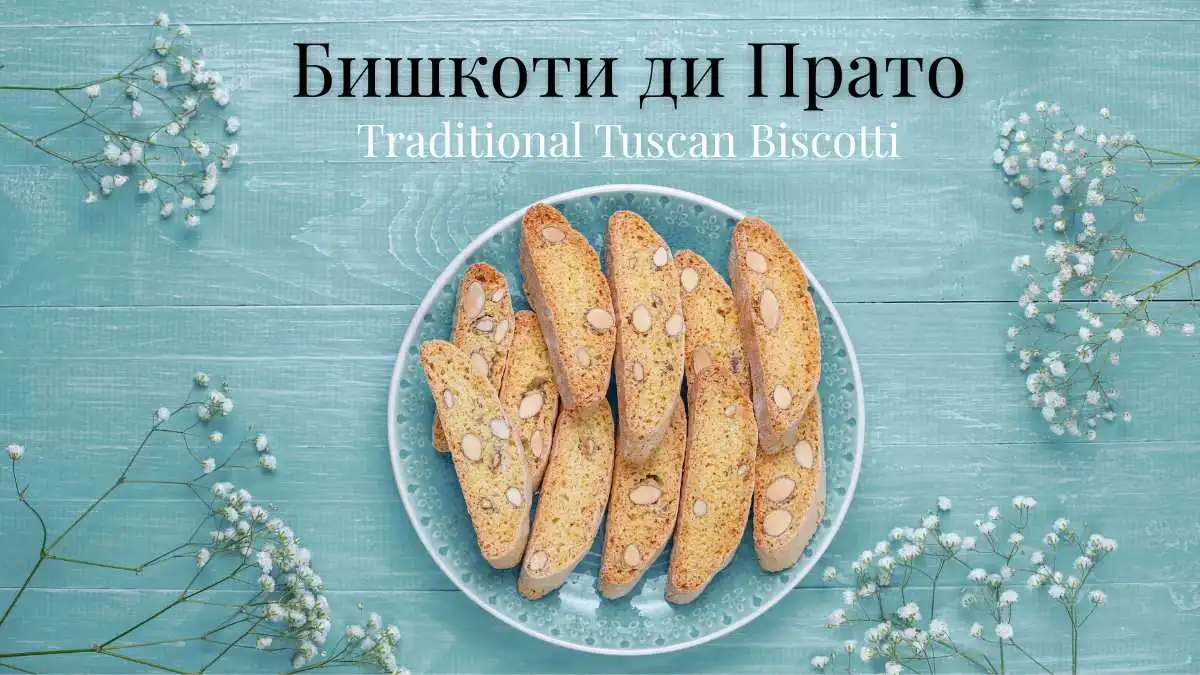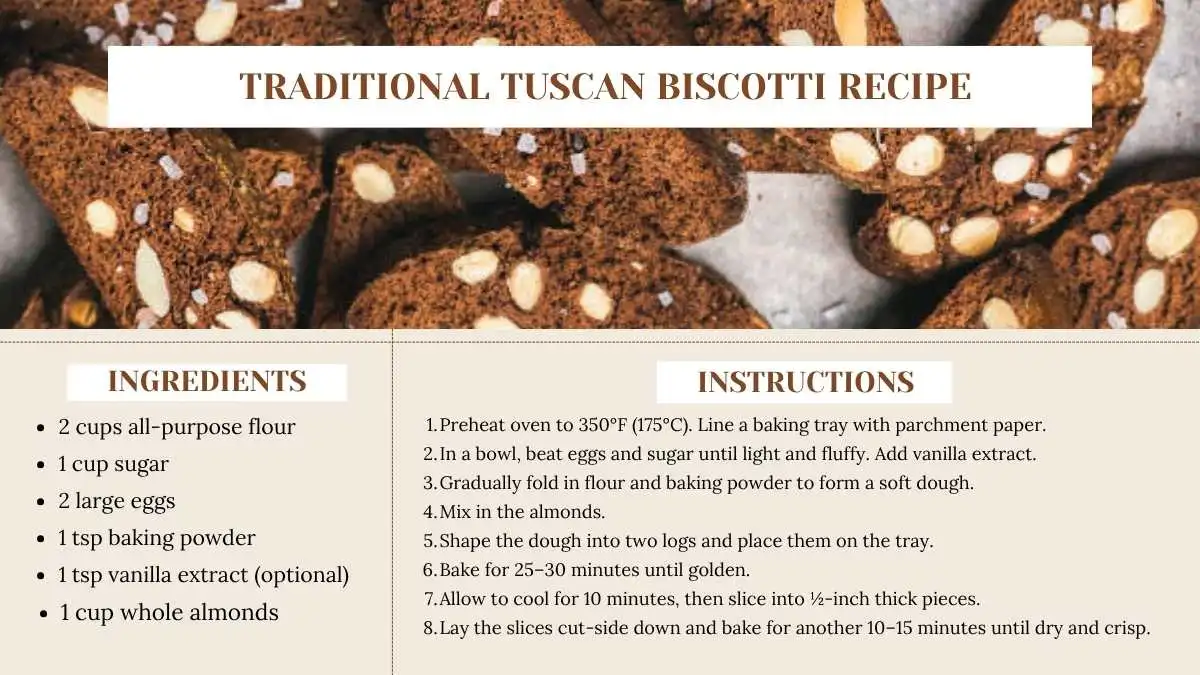FOODS AND DRINKS
Бишкоти ди Прато: Traditional Tuscan Biscotti Recipe & History

Бишкоти ди Прато, known in Italian as Biscotti di Prato, are not just another variety of cookies; they are a symbol of Tuscany’s rich culinary legacy. Originating from the picturesque town of Prato, nestled in the heart of Italy’s Tuscany region, these twice-baked almond biscuits have stood the test of time. Revered for their crunchy texture and delicate almond aroma, these traditional treats are a true testament to the simplicity and brilliance of Italian baking.
A Glimpse into the History of Бишкоти ди Прато
The history of Бишкоти ди Прато dates back to the Middle Ages, with the first written records appearing in 18th-century manuscripts. However, food historians believe that their true origins go back even further. These biscuits were initially crafted by Tuscan bakers as a solution for long-lasting food that could be easily stored and transported, making them ideal for merchants and travelers alike.
The renowned pastry shop Antonio Mattei in Prato is largely credited with perfecting and popularizing the recipe in the 19th century. To this day, Antonio Mattei Biscottificio remains one of the most respected producers of authentic Бишкоти ди Прато.
Traditional Ingredients and Unique Baking Method
One of the most distinctive features of Бишкоти ди Прато lies in its minimalist ingredients. The traditional recipe calls for:
- All-purpose flour
- Granulated sugar
- Fresh eggs
- Whole, unpeeled almonds (sometimes toasted)
- A hint of baking soda or baking powder (in modern variations)
Unlike other Italian cookies, these biscotti do not include any butter or oil, which contributes to their long shelf life and hard texture.
The Double-Baking Process
The name “biscotti” comes from the Latin word biscoctus, meaning “twice-cooked.” This method is the cornerstone of the biscuit’s unique character:
- First Bake: The dough is shaped into logs and baked until lightly golden.
- Cooling and Slicing: After a brief cooling period, the logs are sliced diagonally into individual pieces.
- Second Bake: The slices are baked again, cut-side down, until they reach the desired crispness.
Cultural Significance in Tuscany and Beyond
In Tuscany, Бишкоти ди Прато are more than just a dessert; they are a ritual. They are typically served at the end of a meal with a glass of Vin Santo, a sweet dessert wine produced in the region. The dry texture of the biscotti contrasts perfectly with the syrupy wine, creating a luxurious taste experience when dipped.
Outside of Italy, these biscuits have gained international acclaim. In the United States, they are often referred to simply as “biscotti,” though American versions tend to be more varied, with added chocolate, dried fruit, and even glaze toppings. However, traditionalists insist that true Бишкоти ди Прато must remain faithful to the original almond-based recipe.
Health Benefits and Nutritional Value
Despite their indulgent appearance, Бишкоти ди Прато are relatively health-conscious treats when consumed in moderation:
- Low in fat: The absence of butter or oil significantly reduces the fat content.
- Rich in almonds: Almonds are a great source of protein, fiber, and healthy fats. They also contain vitamin E, magnesium, and antioxidants.
- Long shelf life: With no added preservatives, these cookies remain fresh for weeks when stored properly.
That said, they are still sugar-based confections and should be enjoyed as part of a balanced diet.
Modern Variations and Serving Ideas
While purists prefer the original version, modern adaptations of Бишкоти ди Прато have gained popularity among bakers and chefs who experiment with:
- Pistachios or hazelnuts instead of almonds
- Dark chocolate chips or cocoa powder for a richer flavor
- Orange or lemon zest for a citrusy aroma
- Dipping in melted chocolate for a decorative and flavorful finish
Baking Бишкоти ди Прато at Home: A Simple Guide
Creating authentic Бишкоти ди Прато in your kitchen can be a fulfilling culinary project. Here’s a quick guide to get you started:

Let them cool completely before storing in an airtight container.
Storage Tips and Shelf Life
Thanks to their low moisture content, Бишкоти ди Прато are naturally shelf-stable and do not require refrigeration. Here are a few tips for keeping them fresh:
- Store in an airtight glass jar or tin to maintain crunchiness.
- Keep away from humidity and direct sunlight.
- Avoid plastic containers, which can trap moisture and soften the biscuits.
When stored correctly, they can last for 3–4 weeks without losing texture or flavor.
FAQs
1. Are Бишкоти ди Прато and cantuccini the same thing?
Yes, Бишкоти ди Прато and cantuccini refer to the same traditional Tuscan almond biscuits, though “cantuccini” is a more modern, generic term.
2. How to make Бишкоти ди Прато gluten-free?
Yes, they can be made gluten-free by substituting all-purpose flour with a high-quality gluten-free flour blend.
Final Thoughts
Бишкоти ди Прато are more than a recipe, they are a culinary heritage, a cultural symbol, and a sensory experience. From their humble beginnings in medieval Tuscany to their present-day global fame, these twice-baked almond biscuits continue to enchant people across generations.
Whether you’re a home baker, a traveler eager to explore Italy’s gastronomic traditions, or simply someone looking for a wholesome, crunchy treat, Бишкоти ди Прато deserves a special place on your table.
-

 BIOGRAPHY7 months ago
BIOGRAPHY7 months agoBehind the Scenes with Sandra Orlow: An Exclusive Interview
-

 HOME1 year ago
HOME1 year agoDiscovering Insights: A Deep Dive into the //vital-mag.net blog
-

 HOME1 year ago
HOME1 year agoSifangds in Action: Real-Life Applications and Success Stories
-

 BIOGRAPHY1 year ago
BIOGRAPHY1 year agoThe Woman Behind the Comedian: Meet Andrew Santino Wife




























